Hedge Couture: Discover Unique Trimming Shapes and Expert Techniques
Posted on 09/06/2025
Hedge Couture: Discover Unique Trimming Shapes and Expert Techniques
Welcome to the dazzling world of Hedge Couture! This comprehensive guide will walk you through the essentials of creative hedge trimming, unique topiary designs, and expert techniques for both beginners and seasoned gardeners. Unleash your imagination and transform your green spaces into living masterpieces with the latest tips and artistic inspiration in the realm of hedge design.
What Is Hedge Couture?
Hedge Couture represents the fusion of horticultural expertise and creative expression. It's the art of sculpting hedges and shrubs with precision and style to yield impressive and unique shapes, transforming ordinary gardens into extraordinary landscapes. Whether you aim for classic symmetry, whimsical animal figures, or modern abstract patterns, hedge couture lets you express individuality in your outdoor oasis.
Why Embrace Hedge Couture?
- Personalization: Tailor your garden to reflect your personality and tastes.
- Curb Appeal: Unique hedge trimming shapes can dramatically enhance your property's value.
- Environmental Benefits: Hedges provide habitats, improve air quality, and offer year-round structure.
- Therapeutic Value: The process of shaping and caring for plants can be incredibly relaxing and satisfying.

Popular and Unique Hedge Trimming Shapes
There is a universe of hedge trimming shapes available to the curious gardener. Below, we uncover some of the most iconic and imaginative forms in hedge couture, from traditional to avant-garde.
Classic Geometric Shapes
- Spheres and Globes: Simple, elegant, and suited to formal gardens. They can be used to create a sense of rhythm and repetition.
- Cubes and Rectangular Prisms: These are favorites for driveways, paths, and the famous parterre gardens of Europe.
- Pyramids and Cones: These shapes draw the eye upward and offer a dramatic, architectural look.
Whimsical Figures and Animals
- Animal Topiary: From peacocks to elephants, animals are an ever-popular choice for those who want to showcase their skill and creativity.
- Fantasy Creatures: Dragons, unicorns, or other mythical beings add enchantment to any landscape.
- Human Figures: Creating lifelike people--be it musicians, gardeners, or dancers--requires advanced skill, but the results are mesmerizing.
Artistic Abstracts and Modern Designs
- Waves and Spirals: These flowing shapes mimic natural elements and suit contemporary gardens nicely.
- Topiary Letters and Numbers: Spell out a name, date, or inspirational word right in your garden.
- Multi-Tiered Forms: Combine layers, textures, and heights for a dynamic, dramatic impression.
Expert Techniques for Creative Hedge Trimming
To master hedge couture, it is essential to learn and apply time-tested techniques. Here are key methods and professional advice for crafting everything from symmetrical hedges to one-of-a-kind sculptures.
1. Choosing the Right Plants for Couture Hedges
- Boxwood (Buxus sempervirens): Renowned for its dense foliage and slow growth, ideal for detailed topiary and crisp geometric forms.
- Yew (Taxus baccata): Long-lived and responsive to pruning, yew hedges adapt well to complex designs.
- Ligustrum (Privet): Fast growing and hardy, suited for large topiary figures and seasonal shapes.
- Holly (Ilex): Adds winter interest with glossy leaves and red berries; best for softer, less angular shapes.
- Other Options: Photinia, laurel, myrtle, and even rosemary for creative green sculptures.
2. Essential Tools for Hedge Trimming Artistry
- Shears and Pruning Scissors: High-quality, sharp blades are vital for precise cutting and healthy plants.
- Electric Hedge Trimmers: Perfect for large, straight hedges or removing bulk foliage before detail work.
- Topiary Frames and Templates: Wire forms or guides can simplify creating complex or matching shapes.
- String and Stakes: Use these to outline geometric shapes or to act as sightlines for symmetrical trims.
- Ladder and Safety Gear: Ensure stability when reaching taller hedges, and protect your hands and eyes.
3. Step-by-Step Hedge Trimming Guide
Success in hedge couture starts with careful preparation and execution:
- Plan Your Design: Sketch your intended shape or use a frame. For beginners, start with basic forms, advancing to animals or complex abstracts over time.
- Prepare the Hedge: Remove debris, check plant health, and prune away any dead or damaged branches before sculpting.
- Rough Cut: Use larger shears or trimmers to remove bulk foliage, gradually reducing the size towards your guideline.
- Define the Shape: Switch to smaller, sharp scissors for fine-tuning edges and details. Regularly step back to check symmetry and proportions.
- Finishing Touches: Use gloves to gently smooth out curves or tuck in stray branches. Clean up clippings for a tidy display.
4. Pro Tips for Distinctive Hedge Trimming
- Trim in Stages: Never remove too much at once; regular, moderate pruning encourages healthy, dense foliage.
- Cut Above Buds: Make clean cuts just above new growth points for better shape and regrowth.
- Maintain Sharp Tools: Dull blades can damage plants and create ragged edges.
- Trim During Optimal Seasons: Late spring or early summer is ideal for most species--avoid harsh winter or dry summer pruning.
- Know Your Hedge: Some plants respond differently to heavy pruning; research specific care for your variety.
Advanced Hedge Couture Techniques
- Cloud Pruning (Niwaki): A Japanese technique producing soft, undulating shapes that mimic clouds--excellent for Zen or modern gardens.
- Pleaching: Trees and shrubs are trained to grow on a horizontal plane above a trunk, often used for green screens or living fences.
- Espalier: Though traditionally for fruit trees, this method can be adapted for formalized hedge walls and geometric lattices.
Inspiration: Amazing Hedge Couture Designs from Around the World
Let's explore some globally renowned gardens and the hedge couture ideas that have captured the imagination of visitors for centuries.
Levens Hall (UK)
Home to some of the world's oldest and most extravagant topiary, the gardens of Levens Hall in Cumbria exhibit everything from regal peacocks to intricate chess pieces. The techniques perfected here have inspired generations of hedge sculptors globally.
Marqueyssac Gardens (France)
Overlooking the Dordogne Valley, these gardens feature whimsical shapes and rolling cloud forms. The lush, curvilinear designs exemplify the softer, more abstract side of hedge trimming artistry.
Lednice-Valtice (Czech Republic)
This UNESCO-listed landscape is renowned for its geometric parterres and towering green walls, seamlessly blending traditional symmetry with modern flair.
Maintaining Your Hedge Couture Masterpiece
Even the most stunning hedge couture shapes require ongoing care and maintenance. Here's how to keep your living sculptures healthy and visually striking:
Regular Pruning Schedule
- Light Trimming: Every 6-8 weeks during the growing season retains definition and density.
- Thorough Shaping: At least twice a year, undertake detailed work for fine-tuning shapes.
- Seasonal Adjustments: Prune in accordance with weather and growth cycles for optimal results.
Feeding and Watering
- Fertilize: Use a balanced, slow-release fertilizer to encourage lush green growth.
- Water Consistently: Ensure your hedge receives enough water, especially after shaping or during dry spells.
Pest and Disease Management
- Inspect Regularly: Watch for signs of common issues like box blight or scale insects.
- Remove Affected Branches: Early intervention prevents spread and maintains plant vigor.
Mulching and Ground Cover
- Mulch: Applying mulch around the base conserves moisture and suppresses weeds.
- Ground Covers: Low-growing plants at the base can enhance aesthetics and ecosystem health.

FAQs About Hedge Trimming and Couture Design
Is hedge couture suitable for small gardens?
Absolutely! Compact shapes, mini topiary, and creative forms can work wonders even in the smallest spaces. Consider using potted topiaries or dwarf species for balconies and patios.
How long does it take to create a complex hedge shape?
This depends on the species, desired size, and complexity. Simple spheres can form in one to two years, while large animal or human figures may require five years or more of dedicated pruning and training.
Can I use flowering shrubs for hedge couture?
Yes! Camellias, azaleas, or hydrangeas provide blooms as well as foliage, but keep in mind that frequent sculpting can diminish flowering--balance shape with nature's show.
What is the best time of year to start a hedge couture project?
Late spring or early summer, once the risk of frost has passed and growth is vigorous, is ideal for most species. Avoid extreme weather, which can stress the plant.
Conclusion: Your Path to Mastering Hedge Couture
Hedge Couture is more than a trend--it's an enduring fusion of art and gardening. Through creativity, patience, and the application of expert hedge trimming techniques, you can transform any ordinary green hedge into a remarkable display of living artistry.
Whether you are seeking to emulate world-famous gardens, carve out a tranquil retreat, or boldly showcase your personality, hedge couture offers endless inspiration and gratification. Start with simple geometric shapes and advance towards intricate topiaries or abstract patterns as your skills grow.
Ready to embark on your hedge couture journey? Gather your tools, choose your plant, and let your imagination flourish--your sculpted landscape awaits!

